
Traditionally, the Dutch are resigned to shiver until the King's birthday (April 27th), with only an occasional nice day to keep up their spirits. In the meantime, they cling to other signs of spring, like this hapless little lamb.

Traditionally, the Dutch are resigned to shiver until the King's birthday (April 27th), with only an occasional nice day to keep up their spirits. In the meantime, they cling to other signs of spring, like this hapless little lamb.
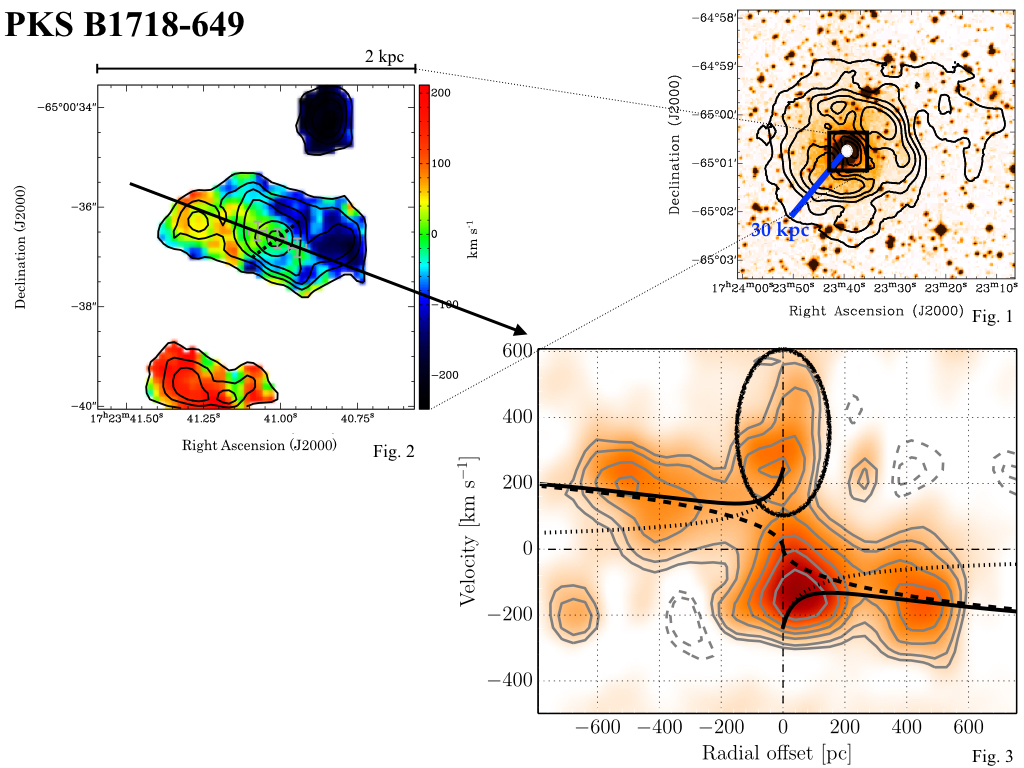 © ASTRON
© ASTRON
Among nearby radio sources, the radio galaxy PKS B1718-649 is estimated to be only 100 yr old: a baby radio source! These young radio sources need to be fed to grow to the tenths of kpc scale of the largest radio sources in the sky (e.g. Centaurus A, Cygnus A). Gas falling into the central black hole of a galaxy is considered the food of an active nucleus, which converts it into energy and re-emits it into the interstellar medium. This phenomenon is believed to have a strong impact in the evolution of the entire galaxy and of its environment.
A few years ago, we observed the atomic neutral hydrogen (HI) of PKS B1718-649 (Fig 1.; Daily Image 10-09-2014 ) using the Australian Telescope Compact Array. Against the very compact radio core (only 2 pc in radius), we discovered, in absorption, two clouds of HI which could be contributing in feeding the radio source.
However, the observations of the HI alone were not able to confirm if the cold gas is fuelling the central supermassive black hole. Hence, we used SINFONI at the VLT to trace warmer gas, i.e. molecular hydrogen (H2) at 2.12 micrometers, in the innermost 2 kpc of PKS B1718-649. As shown in Fig. 2, the H2 is distributed in a double-disk structure, where both disks are rotating. The inner disk (r
The direct detection of cold gas accreting into a young radio source is not common. Follow-up high resolution observations of the colder component of the molecular hydrogen will allow us to further understand the fuelling of this young radio AGN.
These results have been presented by F. M. Maccagni, F. Santoro, R. Morganti, T. A. Oosterloo, J. B. R. Oonk, and B. H. C. Emonts in a recently published A&A paper: arXiv:1602.00701
 © ICRAR/Curtin
© ICRAR/Curtin
As we use rectangle sheets and the stations are setup as a circle, we use 94 sheets arranged in portrait orientation to north and 6 sheets are in landscape orientation.
The total number of sheets enables us to cover a 40 meter diameter circle, hosting a 35 meter antenna placement.
All sheets are 6.0m x 2.4m in 4mm wire with 200mm x 200mm squares.
All sheets will be twitched together with 'Galfan' wire loops (95% zinc, 5% aluminum).
Note that the polygon is symmetrical east/west and also north/south, but NOT on 45 degree diagonals.
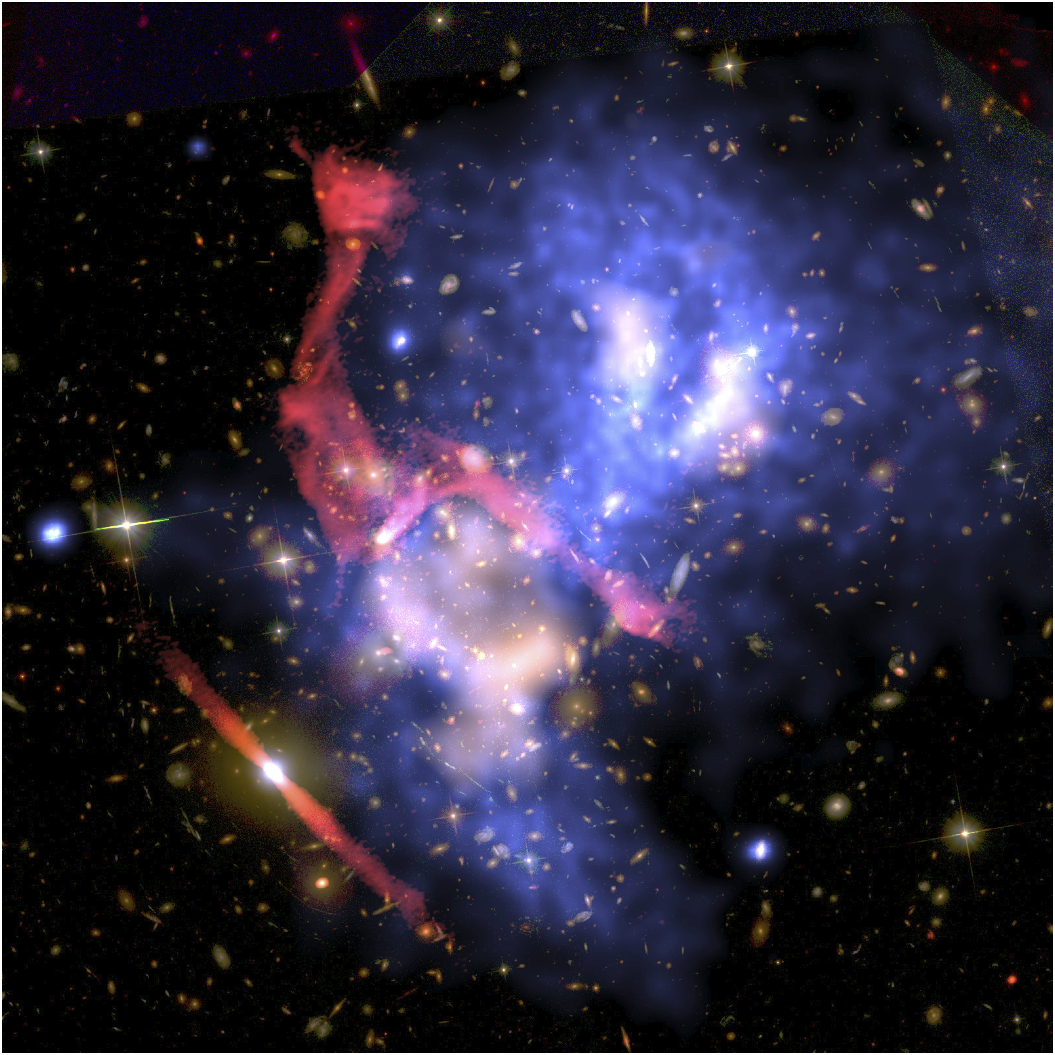 © Tony Mroczkowski
© Tony Mroczkowski
One tool now being used to find clusters at high redshift is the Sunyaev-Zel'dovich effect (SZE), which has redshift-independent surface brightness. To accurately extract cosmological parameters SZE observations, one must better understand how the SZ signature, which is due to thermal pressure, tracks dark matter (i.e. the gravitational potential). While X-ray imaging can infer deviations from thermal pressure support, high resolution SZ imaging -- achieved by a few instruments to date -- directly probes small scale pressure enhancements due to shocks and merger activity.
I will present SZ imaging of a few massive high-redshift clusters with MUltiplexed SQUID/TES Array at Ninety GHz (MUSTANG), the Goddard IRAM Superconducting 2-Millimeter Observer (GISMO), and the Atacama Large Millimeter/Submm Array (ALMA). I will also discuss prospects for GISMO-2, MUSTANG-2, and upgrades to ALMA.
Image: MACSJ0717.5+3745 is a massive (>1e15 Msun), merging cluster at z=0.55 with 5 identified subcluster components. The large peculiar velocity of one subcluster component in particular led to this being the first cluster in which resolved measurements of a non-zero kinetic SZ effect were possible using Bolocam 145 and 270 GHz imaging (see Mroczkowski et al. 2012; Sayers et al. 2013). The image shows MUSTANG SZ 90 GHz Decrement (peach, 9" resolution), Karl G. Jansky Very Large Array (VLA) S-Band (red, 2-4 GHz), and Chandra X-ray imaging (blue) overlaid on the deep, multi-band Hubble Space Telescope (HST) Frontier Fields (FF) imaging. Credit: R. J. van Weeren, produced for the FF and MUSTANG teams.
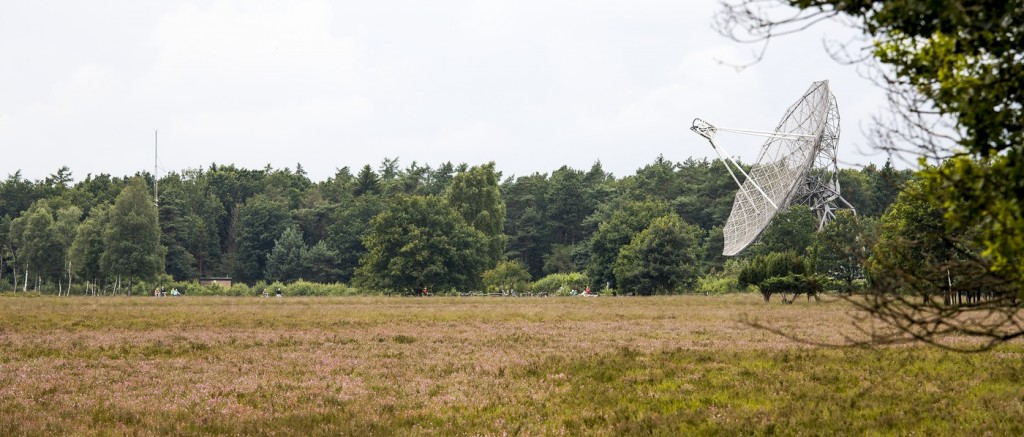 © Wim de Vries
© Wim de Vries
The 60th anniversary will be celebrated by hosting the EUCARA-2016 conference on April 16 and 17, 2016, organised by CAMRAS. EUCARA conferences are organised for and by amateur radio astronomers. The first EUCARA was held in 2014, at the Astropeiler telescope in Stockert, Germany.
The program this year consists of presentations on pulsar and hydrogen observations, large and small SDRs, building equipment, and a keynote by ASTRON's director prof. dr. M. Garrett. There will also be visits to the Dwingeloo Radio Telescope, presentations in an inflatable planetarium, and a Measurement Lab where participants can have their own equipment tested. On Sunday, a tour of the Westerbork Synthesis Radio Telescope concludes the program.
At this moment, over 40 participants from Belgium, Germany, France, Norway, the United Kingdom and the Netherlands have registered. For more information, please visit our website https://www.eucara.nl
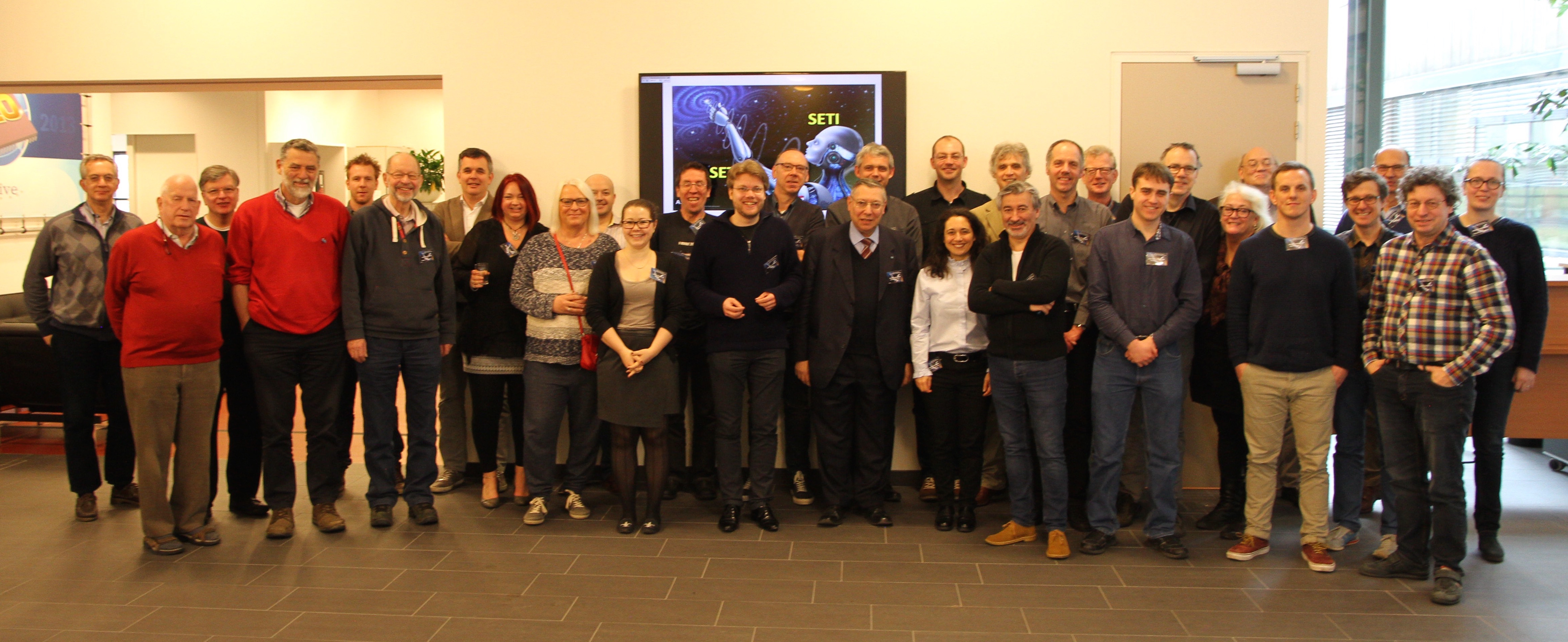 © ASTRON
© ASTRON
The image above presents the obligatory conference photograph. Almost as important, the various presentations are also now available online as PDF files:
http://www.astron.nl/SETI-NL2016/programme.php
 © JvL/Ewald Sadie/Cape Epic/Sportpics
© JvL/Ewald Sadie/Cape Epic/Sportpics
This year "Team ASTRON / SKA SA-NL" (Joeri van Leeuwen and Ewout Aman, a friend of Eric Kooistra) got a much coveted starting invitation, for a race starting with a televised prologue from the U. Cape Town campus, over Table Mountain, followed by 7 days through the sandy and dry Western Cape. Last week, after months of hard training, they thus competed in a field including several Olympic, world and national champions.
For amateurs the goal isn't, of course, to win -- It is to finish the eight, brutal 100-km stages, all off-road and filled with steep big-rock climbs; narrow, hairy descents, and many many kilometers through the desert sands. Without breaking bodies and bikes too much.
After 8 days in the heat; about 20 crashes and many chafing wounds; one wheel completely demolished by a 20-km desert patch, and one 2-km rocky descent on only a rim (!) after an unfixable flat; and after much dust and many many kilometers, Joeri and Ewout finished on Sunday. Proud of finishing, and of their final 76th position in the Open Men category, including pros.
ASTRON technology thrives in the SA extremes; astronomers can too.
 © orru@astron.nl
© orru@astron.nl
The project is structured in four work packages which goals are the following:
The kick-off meeting of BALTICS took place the 18th of February 2016 at the VENTSPILS AUGSTSKOLA (LATVIA). The big picture shows the main representatives of the main partners: Neal Jackson (UMAN), Rene Vermeulen, Rob van der Meer, Roel Witvers, Emanuela Orru (ASTRON), Valdis Avotii, Gatis Gaigals, Evita Vaviina, Eva Fabiga (VIRAC). The small pictures show various moments during the day.
.jpg) © Picture: Steve Torchinsky
© Picture: Steve Torchinsky
Hosted by the South African Astronomical Observatory at their beautiful premises in Cape Town, we saw a focused program with excellent presentations (see http://www.astron.nl/midaa2016/programme.php ). The program was also broad, since one key goal was to identify and make steps towards MFAAs in (South) Africa, involving S.A. industry and the SKA S.A. office. Other initiatives like the development of the African VLBI Network were covered also.
To further stimulate the re-appraisal of MFAAs, a typical Braai was prepared. Participants enjoyed a wonderful sunset cruise, featuring a welcoming whale, followed by a waterfront dinner.
Based on the positive vibes, and the identification of some exciting science cases, a select group was tasked to create a white paper at their earliest convenience.
(*) The EC-FP7 program MIDPREP promotes and enables the exchange of staff and expertise between two leading European research institutes in Sweden and the Netherlands, and three South African university partners. In this way MIDPREP supports the activities of worldwide SKA consortia on radio-optics, calibration, ICT, processing and technology.
 © Rob Millenaar
© Rob Millenaar
Currently (as of March 30th), there are 20 dishes of the MeerKAT array in various stages of construction. Only 44 more to go...
I took this photo from the location of one of the outlying telescopes towards the core in the distance. Those dishes will get a good washing in a minute.
 © R.H. van den Brink
© R.H. van den Brink
The Local Oscillator Generator system (LOG) is a synthesizer generator based on the HITTITE HMC833 PLL. There are two versions at each dish, one for each local oscillator frequency. The two LOG units are required to generate LO1 and LO2 signals for the APERTIF Down Converter Units, called DCU. These systems mix down the antenna signals to the baseband so that the Analog-to-Digital Converter Unit (ADU) can convert it eventually to a digital data stream.
Following the signal through the chain, a reference CLK from the maser enters the input of the buffer card. The differential buffer amplifies and distributes the clock to the PLL-cassette, and to other parts of the APERTIF system who require the clock reference such as other LOG units, ADU (ADC clock) and UNIBOARD. The PLL generates the required LO frequency from the reference CLK. A divider card amplifies and splits these four outputs, where each of them can be amplitude controlled by means of an 15 dB attenuator. All cards can be controlled and monitored by means of the control card. A central control computer (LCU) has access to this control card by means of an Ethernet interface using IP based communication. It uses a TCP stack for this interface. The power card is a low EMI power supply unit, which supplies the cards via the back plane of the LOG system.
As more hardware is getting complete it will be integrated at Westerbork in the coming months.
(*) APERTIF-12 is the second part of the APERTIF project which is divided into two delivery phases. In the first phase (APERTIF-6) six dishes are implemented with the single polarized version of the APERTIF system. In the second phase (APERTIF-12) another six dished will be implemented with the APERTIF system, and all twelve dishes are upgraded to a dual polarized system.?
 © JIVE
© JIVE
 © ASTRON
© ASTRON
De Jonge Akademie ( https://www.dejongeakademie.nl ) is an independent division of the KNAW composed of young top scientists across all domains. Members of De Jonge Akademie serve for 5 years, and are engaged in science policy, science within the context of society, interdisciplinarity, and the international profile of Dutch science.
We wish Jason well in his new and very prestigious appointment!
 © Nienke van der Marel
© Nienke van der Marel
This schematic diagram shows how the dust (brown) and gas (blue) is distributed around the star, and how a young planet is clearing the central gap.
 © ASTRON/CAMRAS
© ASTRON/CAMRAS
Today (friday, April 15th) at 15.00 we will have the premiere of this documentary in the Van de Hulst Auditorium at ASTRON. The image above is its YouTube trailer(*). Everybody is invited to attend this event. Not surprisingly the premiere almost coincides with the 60th anniversary of the Dwingeloo Radio Telescope. It was officially opened by Queen Juliana on April 17th 1956.
The film is available on DVD and costs 20 Euro. The DVD contains the documentary and an appendix which shows all the steps of the restoration in more detail. The 1957 movie of Herman Kleibrink about the construction of the Dwingeloo Radio Telescope is also on this DVD. You can order it via info@camras.nl.
(*) Unfortunately, the Youtube trailer doe not repeat automatically, for some reason. But of course you can view it as often as you like on your own computer.
 © ASTRON
© ASTRON
Via the following link you can have a look at typical item in the database. http://www.astron.nl/RDBE/view.php?id=3
 © Ziggy Pleunis, Cees Bassa, Jason Hessels, Vlad Kondratiev, Sotiris Sanidas & Alexander van Amesfoort
© Ziggy Pleunis, Cees Bassa, Jason Hessels, Vlad Kondratiev, Sotiris Sanidas & Alexander van Amesfoort
The image shows the discovery plot of PSR J1552+54, where you can see its pulse profile and the signal strength as a function of time and observing frequency.
Until recently, pulsar surveys at LOFAR observing frequencies lacked the computational power to adequately correct for the dispersive delay of the ionized interstellar medium. Last year we started using the state-of-the-art DRAGNET GPU cluster, and set out to create a processing pipeline that is able to discover new MSPs with LOFAR.
PSR J1552+54 was found in a pilot LOFAR survey for MSPs in Fermi unidentified gamma-ray sources (LC5_002), which is a major part of my MSc thesis at the University of Amsterdam. The Fermi catalog acts like a treasure map for finding young and millisecond pulsars. We have observed 48 high-Galactic-latitude gamma-ray sources in our pilot program. Half of these observations have been processed so far, and DRAGNET may well be pulling out another MSP signal as we speak. Our new discovery shows the power that both LOFAR and SKA-Low will have for similar surveys, as long as they are attached to a powerful computing cluster.
The research leading to these results has received funding from the
European Research Council under the European Union's Seventh Framework
Programme (FP7/2007-2013) / ERC grant agreement nr. 337062 (DRAGNET).
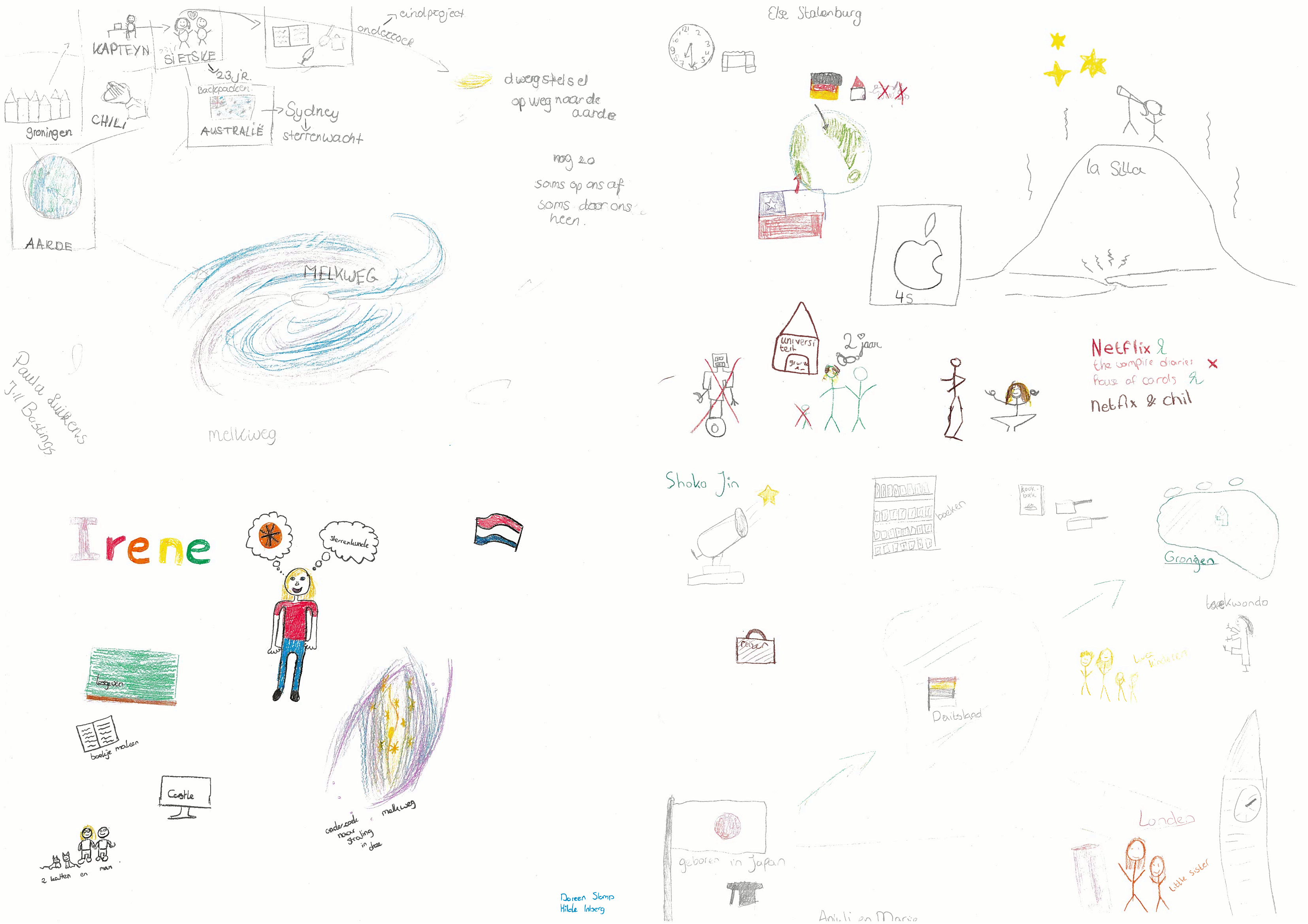 © ASTRON + Girlsday-Girls 2016
© ASTRON + Girlsday-Girls 2016
The chat session involved chatting (via Skype) with a professional female astronomer. All questions were allowed; from work to hobbies to even more personal details. Part of the assignment was to draw their findings onto an A3-paper. Working in pairs, they again produced some magnificent artwork showing the astronomer, her work and many aspects of her personal life. This exercise connects the image of a female astronomer to the personal world of the students.
Many thanks to all the Girlsday-Girls and the female astronomers who volunteered to answer all the girl's questions to make this event so very successful! All drawings have been send to the corresponding astronomer as a reminder of this event.
More information about Girlsday in the Netherlands can be found at http://www.girlsday.nl
 © NTR 2015
© NTR 2015
The video (in Dutch) is aimed at lower high school students (HAVO - VWO, aged 11-14 yr) and will be used by their teachers to kick start the class on this topic.
In the video we first explain what pulsars are (in understandable terms) and continue to explain the electromagnetic spectrum using the NOVA optical bench. It becomes clear that radio has a longer wavelength than visible light. After that we tune in on pulsar B0329+54 whose signals have travelled for ~3000 years, only to be stopped from traveling further by us.
For me it was a really exciting day, not only because of the SchoolTV crew, but also because I got to control the Dwingeloo telescope, after a first set of instructions from Roy Smits and Harm Munk (CAMRAS/ASTRON). The NOVA optical crew (Eddy, Menno and Rik) had put up a beautiful spectrum we could use and the camera man couldn't stop playing around with the lamp and the prism.
The curriculum can be found here:
http://www.ruimtevaartindeklas.nl/lespakketten/onderzoek-naar-pulsars
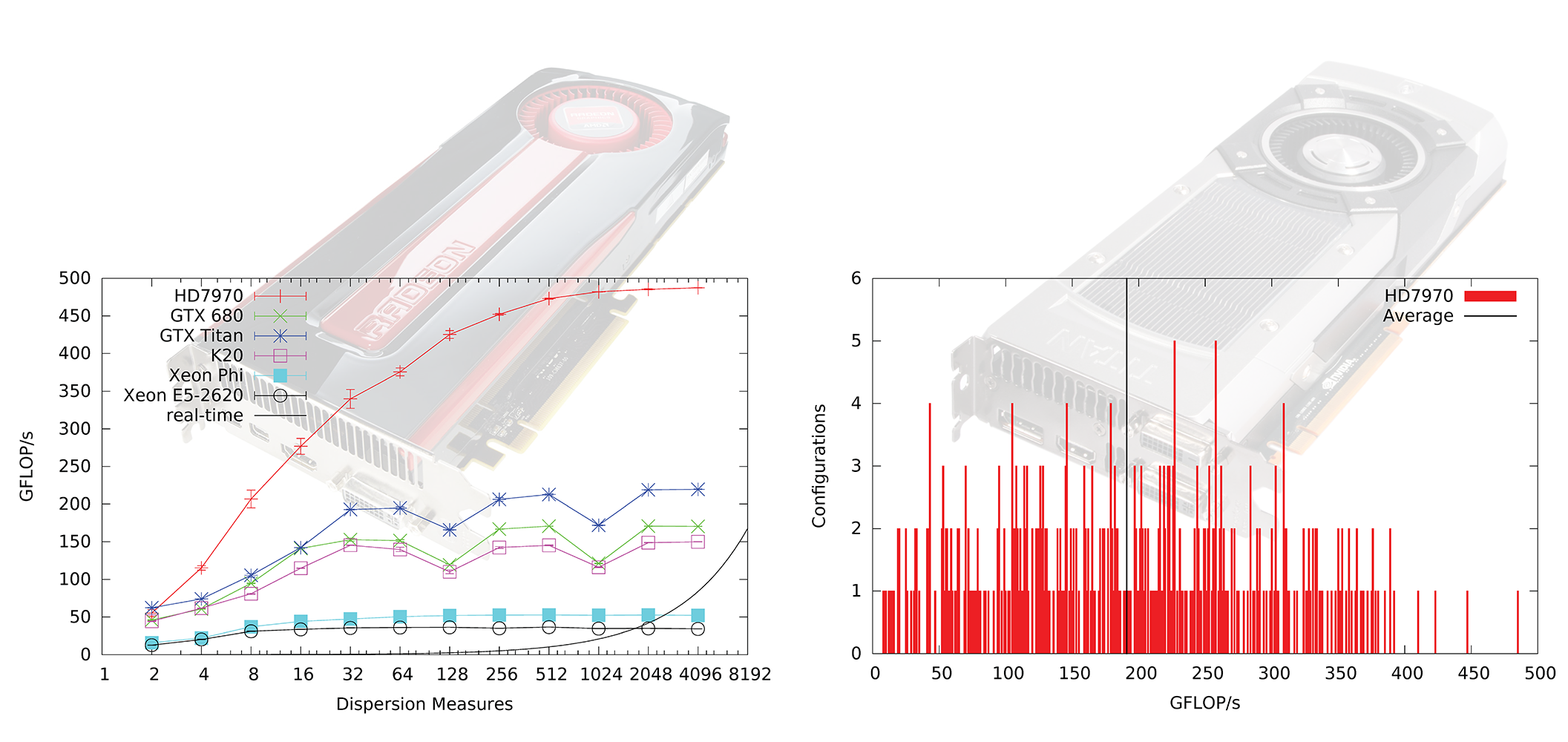 © Alessio Sclocco
© Alessio Sclocco
In our recent paper in Astronomy and Computing we present a study of the parallelization of this algorithm on many-core accelerators, including GPUs from AMD and NVIDIA (shown in the background in the Figure, above), and the Intel Xeon Phi. The team behind this paper consists of a mix of computer scientists and astronomers and includes ASTRON's Alessio Sclocco and Joeri van Leeuwen. Many-core accelerators, such as GPUs, can deliver performance that is orders of magnitude higher than traditional CPUs, resulting also in higher performance per watt and performance per dollar ratios. They are, however, more difficult to program and optimize, thus the focus of our work.
In our results, we find that dedispersion is an inherently memory-bound algorithm, which means that its performance is bound by the memory bandwidth of the platform used for execution, a resource scarcer than computational power. We also find we need to exploit auto-tuning, a technique to automatically select the best parameters for each execution, to adapt the same code to different accelerators, observations, and even telescopes.
In the figure we present two of the plots included in the paper. The plot on the left shows the performance of our dedispersion algorithm on different platforms. You can see that GPUs are faster than the Xeon Phi and traditional CPUs, and are able to compute thousands of DMs in real time. The plot on the right shows the shape of the optimization space of a particular instance. The point to take home there is that optimal configurations can be far from the average, and are thus difficult to predict without tuning.
To conclude, thanks to the contributions of our paper, dedispersion for ALERT will require only 50 GPUs.